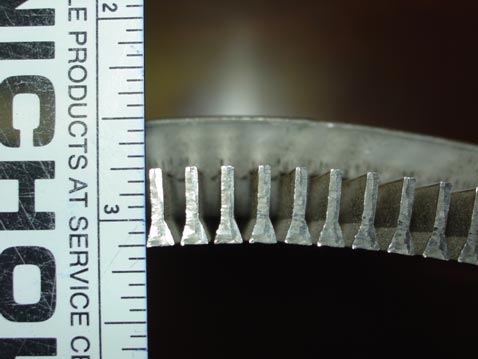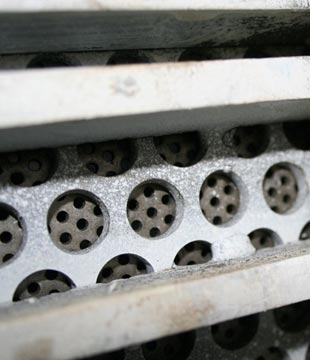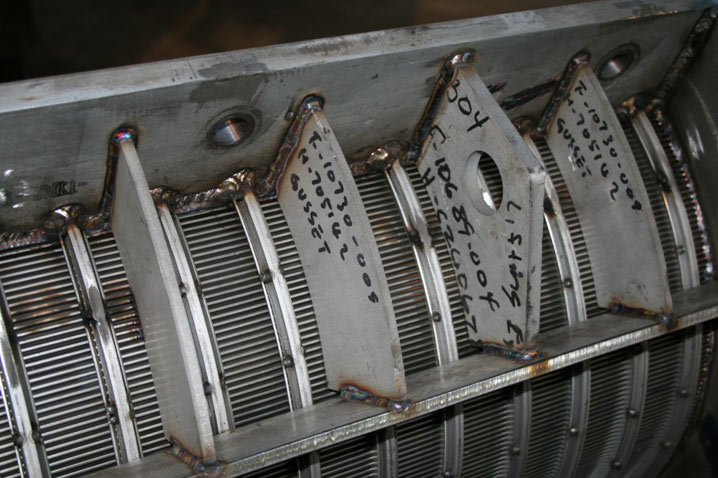October 10, 1995; Updated November 2017
The latest technical improvement in screens for screw presses has been our HVOF (High Velocity Oxygen Fuel) option. This treatment has been found to provide significant additional service life. It is used for highly abrasive applications such as dewatering fiberglass insulation, albumen recovery from eggshells, and sludge at plastic bottle recyclers.
Since the early 1950’s Vincent screw presses have used screens made of perforated stainless steel sheetmetal. It has been only since 1994 with the advent of the Series CP presses that the use of wedgewire construction has become common. Today the choice is guided by the application and historical preference. The initial cost is the same for all screen configurations.
Today the choice between wedgewire and perf is guided by the application and historical preference. The initial cost is the same for all screen configurations.
PERFORATED (“PERF”) SCREENS
The perforation sizes commonly stocked are:
| Nominal | Hole Diam. | Gauge | Thickness |
| 0.5 mm | 0.023 inch | 26 | 0.018″ |
| 1/32″ | 0.033 inch | 24 | 0.023″ |
| 1.25 mm | 0.050 inch | 20 | 0.038″ |
| 3/32″ | 0.094 inch | 14 | 0.075″ |
| 5/32″ | 0.156 inch | 12 | 0.105″ |
| 1/8″ | 0.125 inch | 11 | 0.120″ |
The fractional and millimeter dimensions are nominal hole diameters.
The maximum thickness a sheet of stainless steel in which a hole is punched is limited to one gauge thickness less than the diameter of the hole. Thus the small perforation material is very thin, typically 24 or 26 gauge steel. In contrast, heavier 14 gauge sheets are used for the 3/32″ perf.
The 3/32″ perforation is the standard used in orange peel presses and many other applications. It is preferred because its thickness makes it resistant both to tramp metal damage and to wear when screw-to-screen interference occurs. 1/8″ perf is used in very tough applications such as corn silage, municipal refuse, and out-of-date packaged materials.
Smaller perforation sizes are used where the material being pressed tends to blind (cover over) the holes. This typically occurs with producers of fruit juices (apples, grapes, pineapple, cranberries, pear, tropicals, etc). The smaller sized holes also tend to hold back some fiber from passing through the screen into the press liquor.
(The fibrous solids that do get through the holes can be screened from the press liquor, and then added back to the flow entering the press.)
To improve the bursting strength, a back-up reinforcing screen is employed. Back-up screens for presses with small diameter screws are made of 11 gauge plate with 3/8″ perforated holes. Applications with heavy screens use 7 gauge reinforcing plate.
Perforated screens have the advantage of being an inexpensive material which can be replaced with a minimum of labor.
Surprisingly, in many applications the smaller holes can have more press throughput capacity than larger holes. This is not related to the amount of open area involved. Of course, the smaller hole screens are thinner and more susceptible to damage.
WEDGEWIRE (SLOTTED) SCREENS
A completely different type of screen is made of slotted wedgewire. Wedgewire screens are made of wedge shaped bars of stainless steel which are resistance-welded parallel to each other. The slot width between these bars is specified. To prevent plugging, these bars have a truncated triangle cross-section (a bit like the head of a horseshoe nail).
The wedgewire used in 4″ through most 16″ presses is usually 1/4″ high. For greater hardness and abrasion resistance, these are made of Nitronic 32, a 300 series stainless alloy, high in manganese, nitrogen strengthened. Our 16″ and larger sized presses usually use 3/8″ (9mm) high wedgewire made of 304 stainless steel.
Wedgewire screens have great burst strength. This is due not only to their thickness but also to the fact that they are reinforced from the outside with a honeycomb matrix. This assembly is a one-piece weldment which must be replaced in its entirely when excessively damaged or worn.
Vincent’s wedgewire screens have the advantage that they can be reversed end-to-end. This provides double life in abrasive applications such as paper fiber and sludges containing sand and glass.
Wedgewire screens are produced in flat panels which Vincent has rolled to the nominal screw diameter. The wide base of the triangle cross section faces the material being pressed, thus providing relief on the liquid discharge side.
Typically, Vincent presses use nominal slot widths of 0.010″ (250 microns) and 0.015″ (400 microns). The selection is guided by the application: fine slots are used for alcohol extraction, cooking oil, alginates, and gums with aqueous alcohol. In contrast, manure presses may use very wide slots, up to 0.040″. (As an aside, we have found that perforated screens are generally a better choice for manure.)
Wedgewire screens typically have about 10% open area. This is about the same as most perforated screens when one adjusts for the area blinded over by the reinforcing back-up plate.
 |
 |
|
CROSS SECTION OF WEDGEWIRE SCREEN |
PERFORATED SCREEN WITH BACK-UP PLATE |
 |
|
|
CROSS SECTION OF WEDGEWIRE SCREEN |
|
